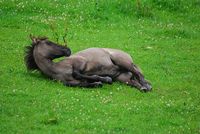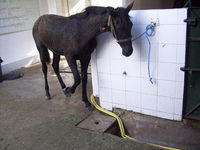Difference between revisions of "Colic Diagnosis - Clinical Signs"
Jump to navigation
Jump to search
| (3 intermediate revisions by 2 users not shown) | |||
| Line 1: | Line 1: | ||
| − | |||
| − | |||
==Clinical signs== | ==Clinical signs== | ||
| − | [[File:Rolling horse | + | [[File:Rolling horse.jpg|thumb|200px|right| Picture of rolling horse (Courtesy of Lily M, WikiMedia Commons)]] |
[[File:Pawing horse.jpg|thumb|200px|right| Picture of horse sweating up and pawing the ground(Courtesy of Potter K, SPANA)]] | [[File:Pawing horse.jpg|thumb|200px|right| Picture of horse sweating up and pawing the ground(Courtesy of Potter K, SPANA)]] | ||
| Line 34: | Line 32: | ||
==References== | ==References== | ||
| − | |||
| − | |||
| − | [[Category:Colic_Diagnosis_in_the_Horse | + | [[Category:Colic_Diagnosis_in_the_Horse]] |
Revision as of 12:19, 18 June 2010
Clinical signs
It is important for the owner or trainer of horses to be able to recognise the clinical signs of colic. This will enable the veterinarian to be contacted as soon as possible to give the horse the best chance of survival.
Signs of Abdominal Pain in order of Increasing Severity
- Repeated lying down and rising
- Inappetence
- Quivering of the upper lip
- Flank watching
- Frequent attempts to urinate
- Kicking the abdomen with hind feet
- Crouching as if trying to lie down
- Sweating
- Dropping to the floor and rolling violently
Other Clinical Signs
- Pawing and/or scraping
- Stretching
- Pacing
- Repeated flehmen response
- Rolling
- Groaning
- Bruxism
- Excess salivation
- Decreased faecal output
- Increased pulse rate and respiratory (see normal values here)
- Congested mucous membranes

